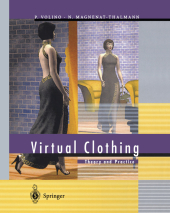 Neuerscheinungen 2012Stand: 2020-01-07 |
Schnellsuche
ISBN/Stichwort/Autor
|
Herderstraße 10
10625 Berlin
Tel.: 030 315 714 16
Fax 030 315 714 14
info@buchspektrum.de |

Nadia Magnenat-Thalmann, Pascal Volino
(Beteiligte)
Virtual Clothing
Theory and Practice
Softcover reprint of the original 1st ed. 2000. 2012. ix, 283 S. 264 SW-Abb.,. 254 mm
Verlag/Jahr: SPRINGER, BERLIN 2012
ISBN: 3-642-63189-4 (3642631894)
Neue ISBN: 978-3-642-63189-4 (9783642631894)
Preis und Lieferzeit: Bitte klicken
In an accessible style that will appeal to the professional, student and laymen, the authors explain the methods for creating and simulating clothes for virtual humans. Using numerous detailed illustrations, colourful images, and step-by-step analysis they map out the terrain of this exciting and cutting-edge discipline.
Starting with the beginnings in the mid 1980s and the basic foundations from the field of mechanics, the reader is gradually introduced to the subject. The text draws on a number of related fields such as computer graphics, algorithmics, computational geometry, simulation, modeling, animation, visualization, and virtual reality. The MIRACloth system, developed by the authors, is used as a case study for the results and techniques discussed. The book comes with a CD-ROM featuring dynamic demonstrations of 3D clothes and fashion shows. This is an indispensable text for anybody who wants an intelligent and readable book on virtual clothing.
1 Introduction.- 1.1 A Brief Historical Background.- 1.2 Problems.- 1.2.1 Shape and Geometry.- 1.2.2 Behavior.- 1.2.3 Interaction with Environment.- 1.2.4 From Cloth to Garment.- 1.2.5 Rendering.- 1.3 Garment Design and Simulation System: An Example.- 2 Simulation Models.- 2.1 Introduction.- 2.1.1 Dynamics.- 2.1.2 Designing a Mechanical Simulation System.- 2.2 Mechanical Properties of Fabric Materials.- 2.2.1 Fabric Mechanical Parameters.- 2.2.2 Experimental Analysis of Fabric Properties.- 2.3 Implementing Mechanical Models.- 2.3.1 Defining Behavior Laws.- 2.3.2 Fundamental Laws of Mechanics.- 2.3.3 Defining a Simulation Scheme.- 2.4 Mechanical Simulation Systems.- 2.4.1 A Good Simulation System.- 2.4.2 Geometrical Models.- 2.4.3 Continuum Mechanics Models.- 2.4.4 Particle System Models.- 2.4.5 A Fast Particle System for Irregular Meshes.- 2.5 Numerical Integration.- 2.5.1 Integration Techniques.- 2.5.2 Choosing the Suitable Integration Method.- 3 Collision Detection.- 3.1 The Collision Detection Problem.- 3.1.1 Introduction.- 3.1.2 Mastering Complexity.- 3.1.3 An Overview of Different Techniques.- 3.1.4 Robustness.- 3.2 A Hierarchical Scheme for Polygonal Meshes.- 3.2.1 Collision Detection on Hierarchical Meshes.- 3.2.2 Optimizing for Self-Collision Detection.- 3.2.3 Efficiency.- 4 Collision Response.- 4.1 Characterizing Collisions Geometrically.- 4.1.1 Intersections and Proximities.- 4.1.2 Collisions and Surface Orientation.- 4.2 Implementing Collision Response.- 4.2.1 Collision Response on Polygonal Meshes.- 4.2.2 Collision Models.- 4.3 Constraints & Seaming.- 4.3.1 Elastics to Bring Objects Together.- 4.3.2 Controlling the Elastic Effect.- 4.3.3 Applications.- 5 Smoothing & Wrinkles.- 5.1 Multilayer Models.- 5.2 A Simple Geometrical Interpolation Algorithm.- 5.2.1 The Problem.- 5.2.2 Constructing the Surface.- 5.2.3 Results.- 5.2.4 Texture as a Height Field.- 5.2.5 Modulating Wrinkle Amplitude.- 5.2.6 Multilayer Wrinkle Textures.- 5.2.7 Rendering Wrinkles.- 5.2.8 Applications.- 6 Rendering Garments.- 6.1 Rendering Techniques.- 6.1.1 Visualization Principles.- 6.1.2 Rendering Systems.- 6.2 Rendering Textiles.- 6.2.1 Anisotropic Lighting of Textiles.- 6.2.2 Volumetric Textile Models.- 6.2.3 Rendering Choices for Realistic Garments.- 7 The MIRACloth Software.- 7.1 Introduction.- 7.2 Approach.- 7.2.1 Design of Garment Patterns.- 7.2.2 Putting Patterns on Bodies.- 7.2.3 Seaming and Constructing Garments.- 7.2.4 Animation of Garments.- 7.2.5 Defining the Garment Materials and Textures.- 7.2.6 Cutting and Modifications.- 7.3 Software Description.- 7.3.1 Program Features.- 7.3.2 Interface Description.- 7.3.3 V.R. Manipulation Tools.- 7.4 MIRACloth at Work.- 7.4.1 Versatile Fabric Simulation.- 7.4.2 Computer Films and Fashion Shows.- 7.4.3 Model Design.- 7.4.4 Garment Prototyping.- 8 Potential Applications.


